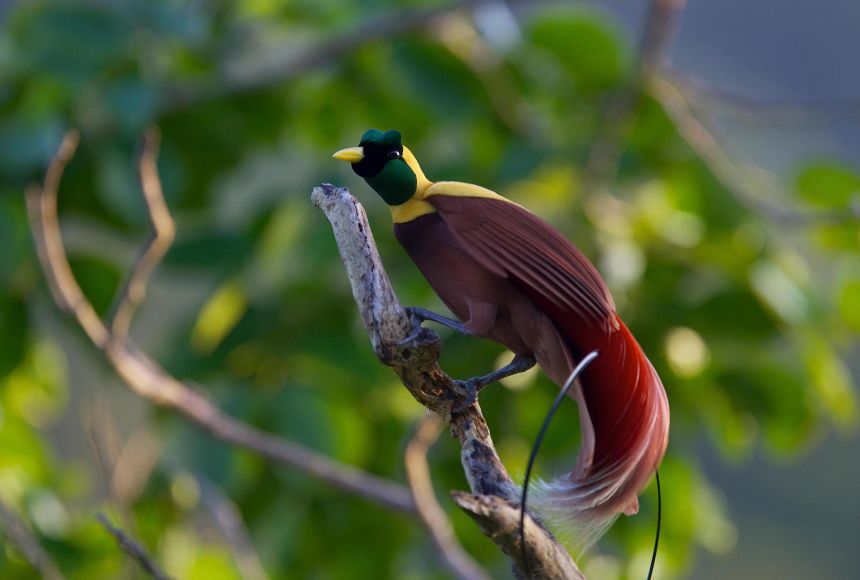In the rainforests of Papua New Guinea, an island country in the Pacific Ocean, male birds-of-paradise gather to display. They look glorious in the morning sun, with fine black tail feathers coiling behind them in ribbons. They let out a repetitive, piercing screech to advertise their presence. A racket of chaotic sounds erupts from the treetops as each bird's call competes with the next. When a female appears, the males begin bobbing and strutting. They fan their delicate wing feathers, each seeking the female's attention.
With their dramatic appearance, it's easy to understand why birds-of-paradise were mistaken for mythical creatures by early explorers. They were first introduced to the Western world in the early 16th century by explorer Ferdinand Magellan. He and his crew brought specimens back from the East Indies. Since then, they have been inspiration for paintings, poetry, and women's fashion.
Birds-of-paradise can be found throughout Papua New Guinea and the surrounding islands of Indonesia. They have also been spotted in a small part of northeastern Australia. There are 39 species altogether, each one different from the next. They come in many colors, shapes, and sizes, from the plain-looking paradise-crow to the extravagant Raggiana bird-of-paradise. The birds are certainly magnificent to look at, but they are perhaps best known for the showy displays they rely on to woo a mate.
Impressive Dance Moves Attract Female Mates
Consider the efforts of the male Superb bird-of-paradise. He shape-shifts into what looks like a smiley face, fanning his pitch-black cape feathers into an oval highlighted by electric-blue feathers. Twitching his feathers frantically, he hops this way and that, making sure the female always gets his best angle. He whirs and clicks and snaps his tail rhythmically, flashing a breastplate of shimmery feathers. The female watches, showing no emotion.
His dance moves may appear unpredictable, but they are carefully choreographed to convince a female that he is the best mate. The male works hard to impress, tirelessly refining his moves until a female is suitably enthralled. After all, she is the one in control.
Stunning as it is, the male's beauty is impractical. For example, take the ribbon-tailed Astrapia, which boasts bright white tail feathers that stretch one meter (three feet) long. Excessively long tail feathers might help this bird-of-paradise attract mates, but they aren't exactly useful for survival.
Darwin's Theory
So how did features like this evolve? According to Charles Darwin's theory of natural selection, traits evolve and become more common in a population if they improve an individual's ability to survive. The Astrapia's bright long tail feathers don't seem to offer any survival advantage. They actually might put the bird in danger by making it easier for predators to spot them.
It's one thing to have a trait that improves your likelihood of survival. Yet the trait has little value if you can't pass it on to the next generation. To account for this, Darwin developed a theory of sexual selection. He suggested that traits can also evolve if they improve an individual's ability to attract more or better mates. This can happen even if those same traits risk long-term survival. Natural selection explains evolution driven by the competition for survival. Sexual selection explains evolution driven by the competition for mates.
Evolution in Action
The dense jungles of Papua New Guinea provide a bounty of food for the birds-of-paradise. There are also few natural predators. These are the perfect conditions for a specific type of sexual selection known as "female choice." Females don't need males to defend them, provide food, or help raise young, so they can be picky about their mate. As a result, males have to work hard to impress them if they want the chance to pass on their genes.
Sometimes, new combinations of genes occur during mating. This can cause new traits to emerge in a population, and the females find these traits more attractive. For example, one year in a population of crow-like birds, a male may be born with longer-than-average feathers. For whatever reason, a female finds long feathers more attractive than short feathers and the two birds mate. Their young inherit both their father's long feathers and their mother's preference for them. Over successive generations, these traits become more and more common in the population. In other words, the preferences of the females literally shapes the appearance of the males over time.
The male birds-of-paradise are certainly a sight to behold, strutting and dancing center stage. But there is more to their performance than first meets the eye. When you look at a bird-of-paradise, you are witnessing evolution in action. Generations of discerning females shaped the male's incredible appearance and outlandish behavior, giving birds-of-paradise their name.

